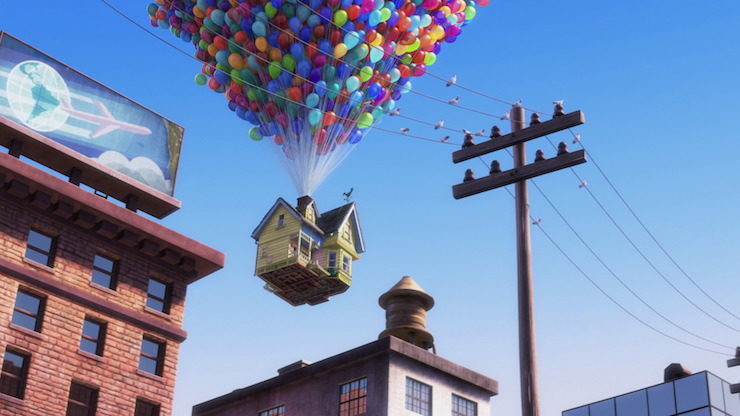By 2004, Steve Jobs had decided that the Pixar/Disney relationship could not continue, largely thanks to the ever-worsening relationship between Steve Jobs and Michael Eisner. This had the positive effect of allowing animators to stop worrying about what the Disney marketing machine might want, and think more of what they might want. For Pete Docter, then primarily known for directing Monsters, Inc. (2001), and now tapped to handle both the English translation of Howl’s Moving Castle and come up with another idea for a Pixar film, this turned out to be the story of a grumpy old man—not exactly Disney’s traditional subject matter. It was virtually the perfect time to pitch his idea, given the corporate drama and—
Squirrel!
Of course, by the time Docter’s film was ready to go into full production, Pixar was right back under the Disney umbrella—if this time mostly under the supervision of Chief Creative Officer John Lasseter, and without the ongoing tensions between Jobs and Eisner. But by the time the Disney takeover of Pixar was completed, in 2006, Docter and other Pixar animators already had a script, concept art, a trip to Venezuela, and various sketches of birds. And the concept—escaping from reality with some balloons—seemed to be a surefire crowd pleaser. Also, the script mentioned adorable dogs. And if the dogs weren’t enough—well, the animators could bring in an adorable kid.
So, despite a protagonist who was not, to put it mildly, a typical Disney protagonist—or even a typical Pixar one, for that matter—Disney agreed to let Docter and the animators proceed on Pixar’s third “non-Disney” film in a row, following Ratatouille (2007), the film that focused on an adorable rat rather than adorable mice, and WALL-E (2008), the groundbreaking science fiction animated film with several minutes without dialogue.
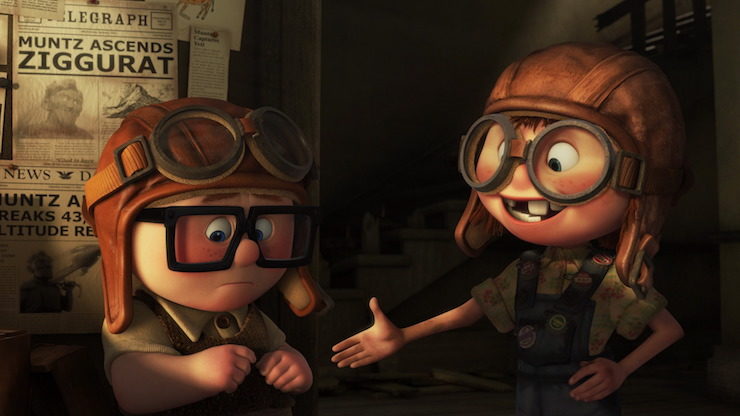
Perhaps in gratitude, or as a partial acknowledgement of the new relationship, the final film contains multiple homages to Disney properties and history. The name of the villain, Charles Muntz, for instance, bears a suspiciously familiar name to an early Walt Disney rival, Charles Mintz—though Muntz himself was largely inspired by Charles Limbaugh, Howard Hughes, and the villains in Indiana Jones films. Dug the dog was somewhat modeled, in colors and pose, on Mickey Mouse’s dog Pluto. In a blink and you’ll miss it moment, a Hidden Mickey shows up in the clouds.
And in a surprisingly moment of what we can call either pure coincidence or one amazingly correct premonition, the final film also contained a few Star Wars references—well before Disney was doing anything other than eyeing Lucasfilm in an interested sort of way.
To voice the villain, Pixar hired Christopher Plummer, probably best known on this site for The Sound of Music and Star Trek VI: The Undiscovered Country. For their elderly, curmudgeonly protagonist, Pixar tapped Ed Asner, then and now probably best known for playing the curmudgeonly Lou Grant in The Mary Tyler Moore Show and its spinoff, Lou Grant. Pixar fixture John Ratzenberger was brought in for a minor role as a construction worker, and various animators and voice actors filled out the rest of the adult and dog roles. Pete Docter stepped in to voice Kevin, the bird—that is, make bird sounds.
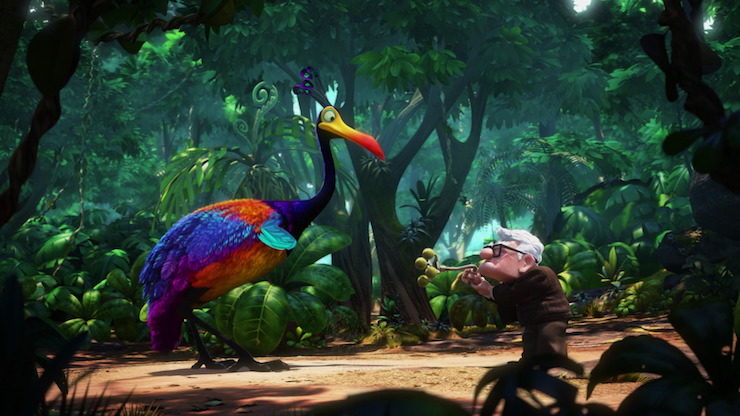
For Russell, a later addition to the film, and the studio’s first Asian American character, a lengthy talent search found Jordan Nagai, discovered when he refused to stay quiet as his older brother auditioned for the role. Docter later noted that after this hopeful, characteristic of Russell moment, young Jordan then had to be coaxed into speaking Russell’s lines, since when not at his brother’s auditions, the kid was deeply shy. Indeed, in various promotional interviews for the film, Jordan Nagai mostly remained silent, allowing Pixar animators to speak for him—and discuss various tricks they used to get the kid to laugh, or sound energetic after multiple takes—including things like tickling the kid, having him run round and round the studio, and sound editing.
Perhaps not surprisingly, after voicing Russell for a few related projects, Jordan Nagai left acting. Reportedly, this decision was in part made by his parents, who felt that both children were too young to focus on professional acting, and would be better off focusing on their education, far away from the Hollywood limelight.
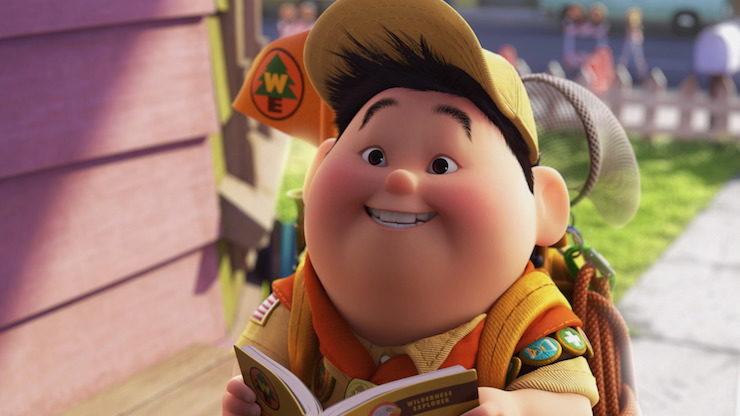
To score the film, Pixar hired Michael Giacchino, whose earlier work for The Incredibles (2004) and Ratatouille (2007) had been immensely successful, garnering Giacchino various Grammy Awards. And as the film moved into production, animators and executives made one more major move, deciding that Up would not only star an unusual protagonist for the studio, but it would also be Pixar’s first ever 3D film—a technology growing in popularity with both filmgoers and theatre chains realizing that they could sell 3D tickets at slightly higher prices. For once, Pixar already had computer processors ready for the task, making the decision a near no-brainer—and the ability to release a 2D print along with the 3D, for viewers less intrigued by 3D technology.
These viewers would include me. Since I can’t see 3D effects on screen (they either look flat or fuzzy to me) I’ve only seen the movie in 2D. It seemed fine. A few scenes here and there were clearly intended to take advantage of the 3D format, but fit seamlessly into the rest of the film. I might very well be missing something, but not an essential “this ruins the entire viewing experience” something.
Anyway. Funding, voices, music and final format secure, Docter and the other animators next had to iron out multiple issues with the story. Early ideas of feuding brothers and a spy skyship were abandoned early on. An idea involving eggs with the ability to grant eternal youth lingered a bit longer, since it had the dual advantage of both providing a motive for the villain and explain why he looked about the same age as Carl, though the early part of the film established that Muntz had to be at least twenty or thirty years older than Carl. Eventually, Docter decided that the eggs were unnecessary, especially since in a film featuring flying houses, colorful chocolate eating birds and talking dogs, a slight age discrepancy would hardly be the most difficult part to believe.
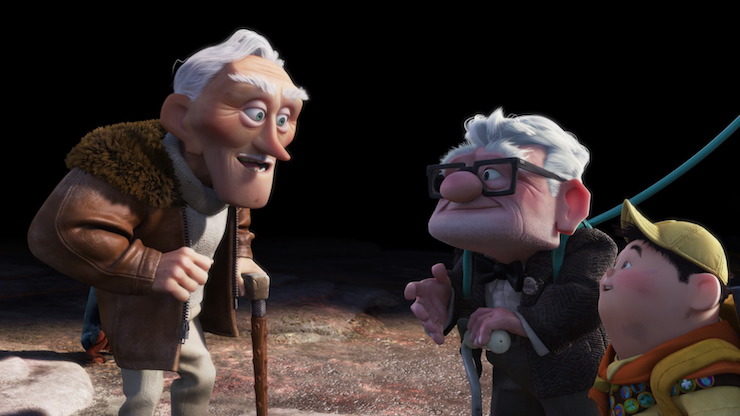
On the other hand, for the talking dogs, Docter opted for a bit of realism—well, as realistic as the concept of talking dogs could get. Previous cartoons, both feature length and short, had, of course, included plenty of talking dogs—but all of those dogs used the speech patterns of humans, turning them more or less into humans who just happened to look like dogs and share a few doglike habits. Docter wanted his cartoon dogs to both speak and be actual dogs, not humans. He decided to equip the dogs with speech collars that would project the dog’s thoughts—thus, creating dialogue that would mimic more or less what dogs really think.
To project that on screen, the animators had to understand how dogs really think. To get a sense of this, animators had a choice: they could consult real dogs, or veterinarians. I am sorry to tell you that they eventually chose the veterinarians, working with animal expert Dr. Ian Dunbar to figure out what dogs might really be thinking. What real dogs thought of the final results remains unknown, but humans laughed.
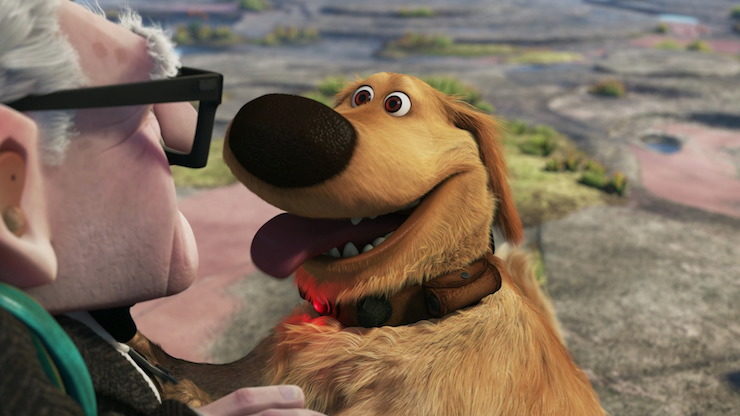
With all that, it was time to animate the film—and yet another milestone in Pixar’s animation history: the opening montage.
The opening is simple enough: young Carl, obsessed with thoughts of adventure, runs into an equally adventuresome girl, Ellie. Their initial meeting does not go all that well: Carl, encouraged to walk across a plank by Ellie, manages to break a few bones—but Carl is smitten. The montage shows their later love affair and shared lives: a wedding, buying and repairing the broken down house where they met, jobs at the zoo, expecting a child, losing the child, saving up for a trip to South America but never quite making it, and then, finally, Ellie’s death.
I’ll admit, even on a rewatch, knowing what was coming, this montage still left me in tears—as did a later, less technically brilliant, but still moving scene where Carl looks through the photographs of the life he had with his wife. The montage is heartbreaking, voiceless, short, and beautifully rendered. It’s not only one of Pixar’s animation highlights, but an object lesson in how much story can be conveyed in a few brief images.
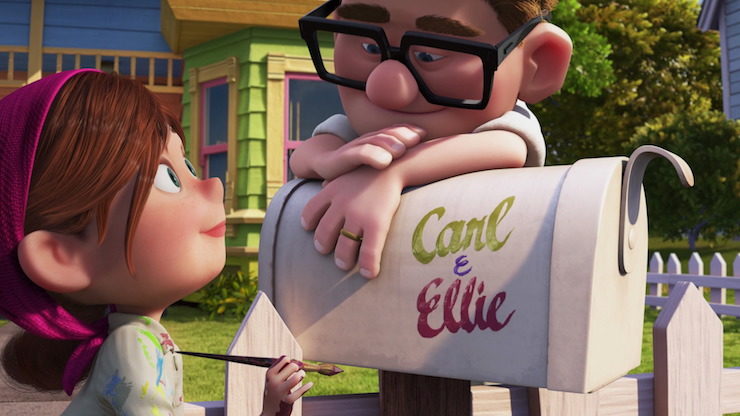
Months, or perhaps years later, Carl is not even remotely over the death of his wife. He is lonely, and still talks to her, and he has a huge problem: skyscrapers popping up all around his house, with developers eager to take his property. Carl wants to stay in the house until he is dead. Given his age and general crotchetiness, it would presumably make sense for the developers to just wait for that, but Carl has ticked them off by pouring assorted substances into their gas tanks, and by refusing to move, so they continue to press—which eventually leads to a violent encounter, a court appearance, and an order to leave his house for a retirement home.
Carl looks at the brochure.
And in a glorious moment, the next moment, he attaches his house to balloons and flies away.
Incidentally, various people, both at Pixar and elsewhere, took the time to calculate just how many helium balloons would be needed to lift a house of that size and weight. The answer, apparently, is “lots,” and by “lots,” Pixar technicians and fans meant “millions.” Unfortunately, even on a large screen, millions of balloons would translate into “lots of tiny dots,” spoiling the effect, so the animators decided to ignore physics and reality and just have a few thousand balloons.
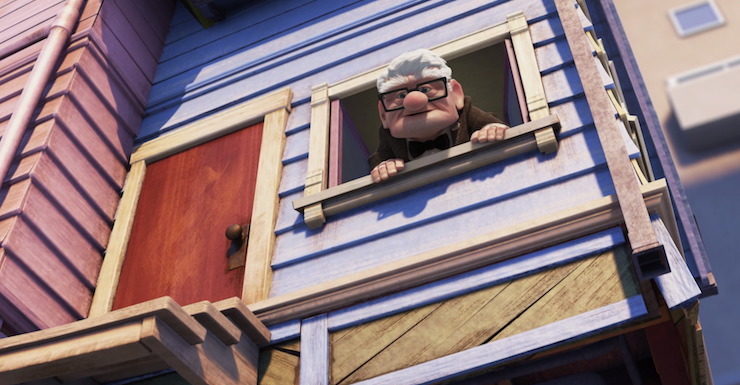
Reducing the balloons from millions to thousands did have the unexpected effect of convincing at least a few viewers that none of this could be real, and thus, Carl is either dreaming or dead. Much though I enjoy the thought of an afterlife filled with colorful, chocolate loving birds and dogs able to voice their thoughts to humans, nothing else in the film particularly suggests the afterlife, and I think a later scene in the film eliminates the dream idea. Carl, after all, is briefly shown daydreaming about dangling Russell from his house—and few people nightdream of daydreaming. Let us instead say that Carl has enough of the spirit of adventure left to transform his fantastic dreams into flight. And just maybe, Ellie’s spirit is helping him there as well.
Anyway. It’s also a lovely theft of homage to The Wizard of Oz—both in the images of the house tossed around while flying through strong storms, and an elderly man lifted away by balloons from a life that no longer fits him—although Carl takes young Russell, a stowaway along (however accidentally) instead of leaving him, like poor little Dorothy, on the ground.
Eventually, the two land in South America, and into the rest of the plot, a complex matter of an obsessed explorer, a colorful bird, several cute dogs, and a showstopping segment involving all of the above and an airship. It injects some by now much needed humor into the film, and contains most of the quotable moments—including the bit that slipped right into current culture: “Squirrel!” said about all easy distractions. (I refuse to confirm or deny that this has been said to or about me.)
As said, this is the fun bit. And yet, while rewatching, I realized that certain parts of Up had been branded into my memory: the opening montage; the sight of the house and the balloons floating over the clouds; Dug saying “squirrel” and “My name is Dug. I have just met you, and I love you”; and the next to last scene, when Carl joins Russell up on the stage as the kid received his very hard-earned badge. But all of the stuff in the middle—that is, the huge subplot featuring an obsessed explorer chasing a big colorful bird? Nothing. I had forgotten every bit of it—even the Star Wars joke (which is pretty good).
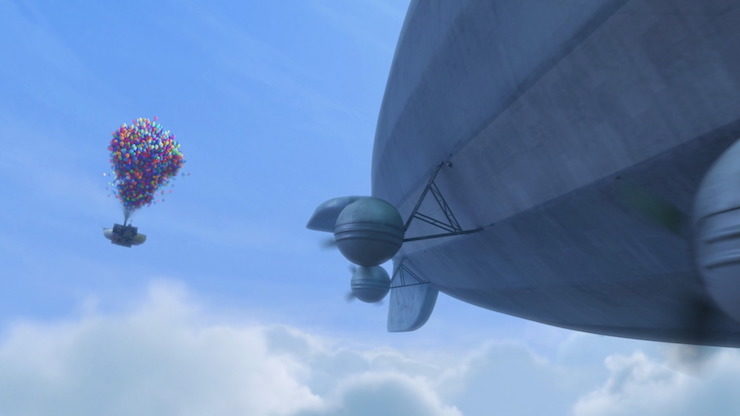
It’s not really that there’s anything wrong with that part of the film—after all, it contains not just adorable dogs, but dinosaur skeletons and plenty of thrilling moments, while providing a dark mirror to Carl’s own journey. Both men, after all, isolate themselves in their homes; both are obsessed with old dreams, often to the point of endangering not just themselves, but others; and both claim to be filled with the spirit of adventure. Meeting Muntz is what allows Carl to start moving on from his grief—a grief that, yes, has sent him soaring into the sky clinging to colorful balloons, but also a grief that has kept him isolated and angry. So I can’t say it’s an unimportant part of the film.
No, I think it’s more that compared to the rich emotions of the rest of the film, it just doesn’t add up. Muntz is a perfectly serviceable villain, as villains go—but although I’m all for keeping big colorful birds out of his control, my main ire is directed at Phyllis, a character who never even appears on screen. Phyllis, who tells a small crushed Russell that he bugs his father too much. With the result that Russell is so desperate to see his father that he’s willing to cling to a flying building, and then help drag the flying building across some rather rough country, with nothing but chocolate to sustain him, just to earn the badge that will let him participate in a ceremony that he hopes—he hopes—his father might come to see. Great job, Phyllis, getting this cute kid to risk his life because you couldn’t take one second to offer the kid some assurance.
Though, in defense of Phyllis, Russell’s dad doesn’t show up at the ceremony (his mother does), so maybe Phyllis was just passing on the message. So, slight change: my main ire is directed at Russell’s dad.
The rest of me is just glad that Carl has found some joy in life again.
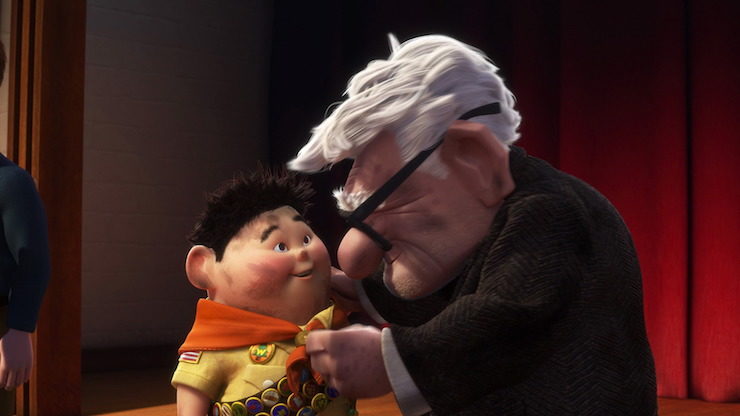
The final film thrilled Disney executives, who arranged for it to be the first film screened at that year’s Cannes Film Festival—a first for an animated film. It received five Academy Award nominations, for Best Sound Editing, Best Score, Best Animated Feature, Best Screenplay, and Best Picture, winning two: Best Score and Best Animated Feature. To this day, it remains one of only three animated features to be nominated for Best Picture. (The others are Beauty and the Beast (1991) and Toy Story 3 (2010).) It also picked up numerous other awards and nominations, including two Golden Globe nominations, three Grammy nods and two wins (again for the score), and a Hugo nod (losing to Moon).
In even better news for Disney executives, Up did well at the box office, bringing in $735.1 million at the box office; it continues to earn more through regular summer matinee releases. The decision to hand out 3D glasses that resembled the thick spectacles worn by Carl in the film undoubtedly helped, but the film did well on 2D screens as well. Disney did not release the usual toy products, but they did release other assorted merchandise, ranging from T-shirts to Christmas ornaments to art books to trading pins; the “Squirrel!” T-shirt is still available at most of the theme parks along with a few trading pins, including the Grape Soda pin.
Pixar had hit its peak, it seemed. The question was how long that peak could continue. Forever, some thought. Maybe just one more film, others thought.
Toy Story 3, coming up next.
Mari Ness lives in central Florida.










